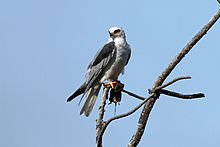White-tailed kite
| White-tailed kite | |
|---|---|
 |
|
| White-tailed kite with prey. | |
| Scientific classification | |
| Kingdom: | Animalia |
| Phylum: | Chordata |
| Class: | Aves |
| Order: | Accipitriformes |
| Family: | Accipitridae |
| Genus: | Elanus |
| Species: | E. leucurus |
| Binomial name | |
|
Elanus leucurus (Vieillot, 1818) |
|
| Synonyms | |
|
Elanus caeruleus leucurus |
|
Elanus caeruleus leucurus
The white-tailed kite (Elanus leucurus) is an elanid kite of genus Elanus found in western North America and parts of South America.
Their coloration is gull-like, but their shape and flight falcon-like, with a rounded tail. Mainly white underneath, they have black wingtips and shoulders. A mid-sized kite, it measures 35–43 cm (14–17 in) in length, spans 88–102 cm (35–40 in) across the wings and weighs 250–380 g (8.8–13.4 oz). Both the wings, at 29–32.8 cm (11.4–12.9 in) each, and the tail, at 15.1–18.6 cm (5.9–7.3 in), are relatively elongated. The tarsus measures around 3.6 cm (1.4 in).
For some recent decades, it was lumped with the black-winged kite of Europe and Africa as Elanus caeruleus and was collectively called black-shouldered kite. More recently it was argued that the white-tailed kite differed from the Old World species in size, shape, plumage, and behavior, and that these differences were sufficient to warrant full species status. This argument was accepted by the American Ornithologists' Union, so the white-tailed kite was returned to its original name. Meanwhile, the Old World E. caeruleus is once again called black-winged kite, while the name black-shouldered kite is now reserved for an Australian species, Elanus axillaris, which had also been lumped into E. caeruleus but is now regarded as separate again.
The white-tailed kite was rendered almost extinct in California in the 1930s and 1940s due to shooting and egg-collecting, but they are now common again. Their distribution is patchy, however. They can be found in the Central Valley and southern coastal areas, open land around Goleta including the Ellwood Mesa Open Space, marshes in Humboldt County, and also around the San Francisco Bay. Elsewhere, they are still rare or absent. They are also found in southern Texas, on the Baja California Peninsula, and in eastern Mexico. Globally, they are not considered threatened species by the IUCN. On rare occasions the bird can be found far outside its usual range. At different times, two had been sighted in New England as of 2010.
...
Wikipedia

